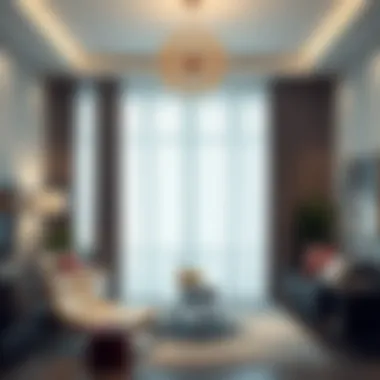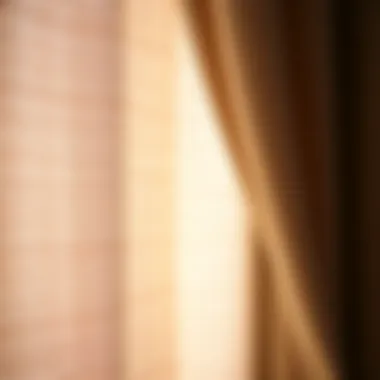Exploring Privacy Window Curtains: Functionality and Style


Intro
The concept of privacy in our living spaces has evolved significantly over the years. In today's fast-paced world, the need for personal sanctuaries has become paramount. That's where privacy window curtains come into play. They are more than just a design element; they serve vital functions like blocking out prying eyes, controlling sunlight, and enhancing the overall aesthetic of a room.
Understanding the various types and materials available can help homeowners, interior designers, and decorators make informed decisions that reflect personal style and functional needs. This guide aims to explore this multifaceted topic, shedding light on the trends, selection tips, and installation strategies that will help maintain a comfortable, stylish space.
Let's delve deeper into the current landscape of furniture design trends and how they intersect with window treatments.
The Importance of Privacy in Home Design
Creating a home that feels safe and comfortable is a cornerstone of good design. Privacy is not just a nice-to-have; it's a fundamental aspect of personal space. In today’s world, where urban settings often overlook the need for solitude, the role of privacy window curtains cannot be overstated. This article discusses why privacy in home design is important, diving into personal boundaries and cultural perspectives that shape our understanding of space and presence within our homes.
Understanding Personal Boundaries
Every individual or family has a unique comfort level when it comes to privacy. Think of it like personal bubbles—some folks might keep theirs tightly held, while others prefer a broader space. The significance of privacy hinges on these boundaries. Curtains, blinds, and shades serve as tangible barriers that help define these comfort zones within our homes. They shield us from prying eyes while still allowing light to filter in, creating a balance that meets our need for both openness and seclusion.
To illustrate, consider a living room facing a busy street. Without the right window treatments, passersby can easily peer inside, making it feel uncomfortable or invasive. By installing privacy curtains, you essentially install a protective layer. Not only does this enhance your comfort, but it also helps in cultivating an environment that supports relaxation and intimacy—all vital in a home setting.
Cultural Perspectives on Privacy
The way we perceive privacy can be deeply influenced by our cultural backgrounds. In some cultures, open spaces and communal living are celebrated, where homes may emphasize connectivity over seclusion. In contrast, other cultures regard personal space as a vital component of daily life. For instance, in Scandinavian countries, there’s a strong preference for homes that offer a serene retreat from the outside world, often achieved through layered window dressings.
Different values influence how people choose their privacy window curtains. In Japan, sheer fabrics are quite popular, serving both to invite light and protect from outside views without completely blocking them. On the flip side, Western preferences may lean towards blackout or heavier materials, prioritizing control over light and sound. Understanding these perspectives not only allows designers and homeowners to make informed choices but also fosters an appreciation for the diversity of needs surrounding privacy in our living spaces.
"Cultural context shapes our perceptions and preferences about privacy, reminding us that home design is about more than just aesthetics; it's about feeling safe and secure."
When designing a living space, integrating privacy considerations can enrich the overall experience. It’s about creating a sanctuary where one feels at ease, all while respecting personal boundaries shaped by culture. With the right window treatments, homeowners gain more than just style; they cultivate a harmonious existence that communicates self-awareness and respect for oneself and others.
Defining Privacy Window Curtains
Privacy window curtains are more than just a decorative addition to your home; they play a crucial role in ensuring a sense of security and comfort in your personal space. As urban environments become denser, maintaining personal privacy grows more essential. This section aims to delve into the key elements that not only define privacy window curtains but also highlight their importance in the modern home setting.
Functionality and Purpose
When considering privacy in home design, one must first grasp the functionality of window curtains. Primarily, these curtains serve to obscure the view into your home from the outside, acting as a barrier—not just visually but also acoustically. They can filter light while maintaining privacy, which is particularly important during daylight hours when the sun shines brightly but nosy neighbors are also lurking about.
Key functions of privacy window curtains include:
- Light Control: Different types of curtains allow varying amounts of light, enabling homeowners to enjoy sunlight while keeping prying eyes away.
- Noise Reduction: Some materials, especially heavier fabrics, can help dampen sound, creating a more serene environment.
- Insulation: Curtains can contribute to energy efficiency by keeping heat in during winter and out during summer, adding to the overall comfort of a living space.
Furthermore, privacy curtains can be tailored to specific needs. For instance, sheer curtains might suffice in a less densely populated area at night, while blackout curtains can provide full seclusion when needed. For a luxurious touch, layered systems can offer a versatile solution, granting control over both light and privacy levels.
Aesthetic Enhancement
The aesthetic value of privacy window curtains cannot be underestimated—they can serve as a focal point in a room or harmonize seamlessly with existing decor. The right set of curtains can transform the atmosphere of a space, imposing style and elegance.
Consider the following aesthetic contributions of privacy window curtains:
- Texture Variety: Different fabric compositions add depth and contrast, enriching the visual experience of a room. Consider a rich velvet for a touch of opulence or light linen for breezy sophistication.
- Color Palettes: An array of colors allows homeowners to express their personality and tie in with the overall color scheme of their living space.
- Design Patterns: Patterns—big or small—can add interest. A bold geometric print can inject modernity, while floral designs might evoke a more rustic or traditional feel.
Ultimately, curtains are not merely functional; they help curate an emotional ambiance, making spaces feel inviting and personal. Potential buyers should explore options that resonate with their style whilst providing the necessary privacy.
"Good design is about balance; while functionality matters, aesthetics can set the mood for how we experience our space."
With the right understanding of privacy window curtains, homeowners can make choices that address both practical needs and stylistic desires, laying the groundwork for a thoughtfully designed haven.
Types of Privacy Window Curtains
When it comes to enhancing both the functionality and the aesthetics of our living spaces, the type of privacy window curtains chosen plays a crucial role. Different curtains serve various purposes, offering options that cater not only to design preferences but also to practical needs. From controlling light to adding warmth, understanding the types of privacy window curtains can aid homeowners and decorators alike in making informed decisions.
Sheer Curtains
Sheer curtains are a popular choice for those seeking a bright and airy ambiance. These lightweight fabrics allow natural light to filter through while providing a level of privacy, making them ideal for living rooms, dining areas, and even bedrooms. The beauty of sheer curtains lies in their versatility; they can be hung alone for a soft look or layered with heavier drapes for more depth and texture.
- Style Options: Available in various patterns and colors, sheer curtains can match any interior design.
- Privacy Level: They provide some cover from outside gaze but do allow for glimpses of movement within.
- Maintenance: Often machine washable, they are easy to care for, but lighter colors may require more frequent washing to maintain their pristine look.
"Sheer curtains bring a refreshing vibe to a room, acting as a bridge between the indoors and outdoors."


Blackout Curtains
Blackout curtains are the ultimate choice for those needing complete light blockage. They're perfect for bedrooms, home theaters, or any space where darkness is essential. These curtains are made with special fabrics that prevent light from penetrating, ensuring a restful environment that promotes better sleep or a focused, distraction-free workspace.
- Insulation Benefits: They also help in temperature regulation, keeping the room cooler in summer and warmer in winter.
- Noise Reduction: Beyond light blocking, they often reduce outside noise, creating a more serene atmosphere.
- Variety: Available in different styles, from minimalist to ornate designs, they can complement various decor themes while boosting functionality.
Thermal Curtains
For those interested in energy efficiency, thermal curtains present a practical solution. Crafted with insulating materials, these curtains help manage heat loss during winter and prevent heat gain during summer, making them a cost-effective choice for homeowners.
- Energy Savings: By reducing heating and cooling demands, they can help cut energy costs.
- Comfort Enhancement: They maintain a more consistent indoor temperature, contributing to a comfortable living environment year-round.
- Design Flexibility: Available in various colors and styles, these curtains do not sacrifice aesthetics for efficiency.
Layered Curtain Systems
Layered curtain systems offer a unique approach to window treatment, combining different types of curtains to achieve both privacy and design complexity. This method allows homeowners to mix sheer and blackout or thermal materials for a customizable experience tailored to specific needs.
- Adaptive Functionality: Easily adjust the layers to manage natural light throughout the day, or draw them for added privacy at night.
- Visual Interest: The combination of different textures and patterns creates an appealing visual impact, enhancing the overall decor.
- Versatility: They work well in any room, instantly transforming spaces with added depth and dimension.
In summary, understanding the variety of curtain types available can significantly elevate both the privacy and style of your home. Each option comes with its unique benefits, making it essential to consider your specific needs when selecting the right type of curtain.
Material Considerations
When choosing privacy window curtains, the materials they are made from play a pivotal role in determining various aspects, from functionality to aesthetic appeal. The right material can significantly affect how well the curtains serve their purpose, including light control, heat retention, and even the ease of cleaning. Understanding the properties of different fabrics helps homeowners and designers alike make informed decisions that align with their specific needs.
Fabric Choices
Cotton
Cotton is a classic fabric that many homeowners lean towards for window treatments. Its softness and breathability make it an inviting choice for any space. One of the biggest advantages of cotton curtains is their ease of maintenance. They can usually be machine washed, creating convenience for busy households. Furthermore, cotton curtains provide a welcoming feel while still offering a fair amount of light diffusion. It's important to note that while they do a decent job at blocking some light, they may not provide complete privacy, especially at night when the interior lights are on.
- Characteristic: Soft and breathable.
- Benefit: Easy to clean, ideal for casual settings.
However, cotton does have a downside. It can fade over time if exposed to direct sunlight for long stretches, which might require replacement or additional layering to maintain an attractive interior style.
Polyester
Polyester is another widely used material in privacy curtains. This synthetic fabric boasts durability and resilience. Unlike cotton, polyester holds its color well and resists wrinkling, making it a lower-maintenance option. Its ability to block out light effectively can be a significant plus for bedrooms or home theaters where privacy and darkness are essential.
- Characteristic: Durable and colorfast.
- Benefit: Great for minimizing light and easy to maintain.
Nevertheless, the texture may not be as soft as cotton, leading some to feel less comfortable with it. Polyester also tends to retain heat more than natural fibers, which could be a consideration depending on the climate or the specific room design.
Linen
Linen, known for its elegance, offers an organic look that appeals to many homeowners. This fabric is naturally hypoallergenic and strong, an advantageous feature for those with sensitivities or concerns about durability. The light, airy quality of linen curtains contributes to a relaxed ambiance, while still offering a level of privacy. However, due to its natural fibers, linen is prone to wrinkling.
- Characteristic: Organic feel with breathability.
- Benefit: Elegance and hypoallergenic.
The downside, however, is that linen typically requires more care compared to cotton or polyester; it may be best suited for spaces where look is paramount, even if that means some extra effort in terms of upkeep.
Sustainability Factors
Sustainability is increasingly becoming a key deciding factor for many homeowners when it comes to choosing materials. As awareness of environmental issues grows, the demand for eco-friendly fabrics, such as organic cotton or recycled polyester, is on the rise. Opting for sustainable materials not only benefits the environment but also aligns with a growing trend among consumers who place value on ethical choices. A detailed look into these materials can be explored further in resources like Wikipedia.
When weighing material choices, consider factors like source, processing, and how well they align with personal values related to environmental impact. Engaging with suppliers who provide transparency about their products can also go a long way in ensuring that what you choose for your home reflects your standards and concerns.
"Choosing the right materials for window treatments can transform not just the look of a space, but also how one feels in it. Think about sustainability and comfort together for the best results."
By keeping these material considerations in mind, you’ll be on your way to selecting privacy curtains that strike a balance between functionality, aesthetics, and ethical standards. Therefore, investing time in understanding these various fabrics can yield benefits that resonate in the long run.
Measurement and Installation
Understanding how to measure and install privacy window curtains is crucial for achieving a satisfactory and functional result that enhances the space. Correct measurements not only ensure that the curtains fit properly but also play a significant role in emphasizing the room's aesthetics. Miscalculating can lead to ill-fitting curtains that hamper privacy and compromise design. This section will discuss important elements related to measuring for curtains and the various installation techniques that make hanging them a breeze.
Measuring for Curtains
When measuring for curtains, one must be careful and precise. To begin, it's essential to determine where the curtain rod will hang. This can be above the window frame to create the illusion of height, or at the frame itself for a more traditional look. Here are the basic steps to follow for accurate measurements:


- Width Measurement: Measure the width of the window. Add a few extra inches on each side for a fuller effect. Curtains that extend beyond the window frame can block outside views and improve privacy.
- Length Measurement: Decide how long you want your curtains to be. Options include just below the window sill, extending to the floor, or pooling on the floor for a dramatic look. Pay attention to where you want the fabric to hit on the floor to avoid unintentional trips!
- Draw Attention to Patterns: If you're using patterned curtains, be sure to center the pattern while measuring. It's all about looking balanced.
By taking these sectional measurements accurately, you set yourself up for success when it comes time to install.
Installation Techniques
Installing privacy curtains can be done in two primary ways— rod installation and track systems. Each method brings its own set of advantages and drawbacks.
Rod Installation
Rod installation, a classic choice for many homeowners, remains popular due to its straightforward approach and versatility. This method involves mounting a rod where the curtains hang freely. It's a great option for those who love to change their curtains with the seasons or simply want an accessible way to open and close them.
The most noteworthy characteristic of rod installation is its ability to showcase decorative rods that enhance the room's look. For instance, a wrought iron rod can add a touch of elegance, while a modern wooden rod might capture a casual vibe. Here are some advantages of rod installation:
- Easy to Install: Many curtain rods come with brackets and simple instructions, making installation manageable for most DIY enthusiasts.
- Wide Variety of Styles: From ornate to minimalist options, there's a rod that fits every decor.
However, it's vital to note that rod installation may not offer the best functionality in tightly spaced areas where curtains might get snagged.
Track Systems
On the other hand, track systems offer a more contemporary take on hanging curtains. This method employs tracks that allow the curtains to glide open and closed smoothly along the rail. It’s particularly useful for larger windows or sliding glass doors.
One of the primary features of track systems is their clean lines, creating a streamlined look that suits modern interiors. The following points outline why track systems can be advantageous:
- Efficiency in Space: Curtains glide effortlessly, making it easier to manage larger openings without the fuss of fabric dragging or getting caught.
- Flexibility of Design: Designed for heavier curtains, track systems can accommodate a variety of weights and styles.
On the flip side, track systems can sometimes be less visually appealing when exposed, although decorative track options are available.
Overall, selecting the most suitable installation technique hinges on both functional needs and personal style preferences. With accurate measurements and the right installation approach, curtains can effectively enhance both privacy and the overall feel of any space.
Decorative Elements and Styles
Choosing the right decorative elements and styles for privacy window curtains isn't just about aesthetics; it plays a pivotal role in enhancing the overall feel of a space. While the primary function of these curtains is to provide privacy, their design choices can significantly complement and elevate your interior. This section will explore how the right style can tie together an entire room, making it feel cohesive and thought-through.
Match with Interior Design
When selecting privacy curtains, it’s essential to think about how these pieces will fit into your overall design scheme. Each individual space tells a story, and the curtains can act as a chapter that reinforces that narrative.
- Harmony is Key: Ensure that your curtains match or enhance the existing color palette. If your walls are painted in soft pastels, consider light-colored sheers that will keep the look airy. Opting for bold colors or intricate patterns can sometimes throw everything off balance, unless that’s the exact aesthetic you wish to achieve.
- Texture is Important: The texture of your curtains can add depth. For example, a rough linen fabric might evoke a rustic charm, while smooth satin can lend an air of elegance. Mixing different materials smartly can provide contrast, but too much variety could lead to visual chaos.
- Style Cohesion: Whether your home leans towards a traditional aesthetic, a modern minimalist vibe, or a cozy bohemian flair, ensure your curtains resonate with that essence. Charts and online resources from sites like Britannica can offer insights into historical styles that can influence contemporary choices.
Patterns and Colors
Patterns and colors are intrinsic to how privacy curtains interact with light and space. Here are some things to consider:
- Light or Dark Colors: Light colors can create a more open feel, making small spaces seem larger. Conversely, darker shades tend to add sophistication but can sometimes make a room feel constricted.
- The Role of Patterns: Patterns can range from geometric designs to florals. For example, a large floral print may evoke a certain whimsy, while stripes might introduce a sense of verticality. Keep in mind that overly complex patterns can compete with other elements in the room, pulling focus away from beautifully curated decor.
- Seasonal and Emotional Impact: Certain colors can influence mood. For a cozy winter feel, warmer tones might be more suitable. During the summer, bright and airy colors could help bring the cheerful energy of the outdoors inside.
In essence, when it comes to privacy curtains, decorative elements shouldn't be an afterthought. Instead, they should weave into the fabric of your space, creating a narrative that reflects personal style while serving functionality.
Always remember that the choices you make in styles and colors can leave a lasting impression on visitors. Every element should align with the message you wish to convey through your living environment.
In sum, achieving a perfect match with interior decor while thoughtfully considering patterns and colors is vital to creating a cohesive and inviting atmosphere. By emphasizing aesthetic harmony, these decorative aspects can enhance your window curtains' effectiveness and contribute to a more satisfying home experience.
Privacy Curtains for Different Spaces
When it comes to decorating our homes, we often overlook how crucial privacy is in various environments. Privacy curtains not only serve practical functions—they enhance the overall aesthetic appeal and comfort of your spaces. Each room has its own vibe and purpose, and understanding how to apply privacy curtains effectively can lead to creating an atmosphere that feels just right for you and your family. In this section, we will break down how different types of privacy curtains can be integrated into living rooms, bedrooms, and office spaces.
Living Room Solutions
In the living room, where both relaxation and social interactions happen, privacy curtains can strike a delicate balance between openness and security. Sheer curtains can enhance light while maintaining a semblance of privacy. They allow you to enjoy the day’s light without feeling like you're on display for passersby.
However, if you find yourself in a neighborhood where close proximity to neighbors reigns, blackout curtains could be your best bet. They not only block light but also dull any outside noise, creating a serene atmosphere. A layered approach, using both sheer and blackout curtains, gives you the flexibility to adapt to varying times of day and moods. Your window dressings can become a beautiful design statement with the right choice of patterns and colors, perfectly complementing your interior design. Make sure the color scheme harmonizes with your couch, cushions, and art pieces, creating an inviting yet private ambiance.
Bedroom Considerations
Privacy in the bedroom is perhaps the most vital. After all, it’s a sanctuary intended for both rest and intimacy. Here, curtains serve the dual purpose of blocking light and creating a personal space. Blackout curtains are essential for ensuring that morning light doesn’t disrupt your sleep. Consider heavier fabrics that provide sound insulation, which can be particularly beneficial if you live in a bustling area.
Moreover, opting for curtains that match your bedding style can tie the room together. Think about materials like linen or cotton that lend a soft touch while maintaining functionality. Adding in thermal features can contribute to energy savings, making the bedroom not just a resting place, but a sustainable choice as well.


Office Spaces
When it comes to office spaces, privacy curtains can redefine your work environment. Whether you have a home office or a small cubicle, using curtains strategically can create a personal haven that fosters productivity. For those using rooms for dual purposes—say a guest room that doubles as an office—consider dual-layered curtain systems. This way, you can adjust the amount of light entering while also providing necessary privacy during work hours.
A patterned or textured fabric can add character while still serving functional purposes. Make sure your selection aligns with tasks you perform in the space. For example, a more formal look might suit professional meetings, while something more relaxed could help with creative endeavors. With the right curtains, your workspace can be adapted to support both focus and creativity.
Remember, the type of fabric and color not only affects your privacy but also your productivity.
Creating privacy zones in different spaces can significantly enhance your living experience. It’s about more than just blocking out light—it's about fostering the right mood and making your home truly yours. Adjusting curtain styles according to the room's requirements allows you to enjoy a thoughtful blend of beauty and security.
Maintenance and Care
Maintenance and care of privacy window curtains are crucial aspects that often get swept under the rug. Having the perfect curtains is just the first step; keeping them looking pristine over time is equally essential. Proper care can prolong their lifespan and maintain their functionality, allowing you to enjoy the privacy and beauty they offer without interruption.
Cleaning Techniques
Over time, dust, dirt, and other environmental factors can cause curtains to become dull and dingy. Here are some effective cleaning techniques that can help you keep your curtains looking fresh:
- Dust Regularly: Use a microfiber cloth or a gentle brush attachment on a vacuum cleaner to remove dust and particles. This should be done at least once a month to prevent buildup.
- Wash According to Fabric Guidelines: Always check the care label attached to your curtains, as different materials require different cleaning methods. For example, cotton curtains may be machine-washable, while delicate fabrics like silk might need hand washing or dry cleaning.
- Spot Clean Stains: For small stains, rely on a mild detergent mixed with water. Using a soft cloth, gently dab the stained area. Never rub rigorously; instead, a light touch will prevent damage to the fabric.
- Steam Cleaning: This method is particularly effective for heavy curtains that cannot be easily removed. A steamer can help reduce wrinkles and refresh the fabric without the hassle of washing.
"Maintaining clean curtains not only improves their appearance but also enhances the overall aesthetic of your living area."
With these techniques, you can effectively maintain the beauty of your curtains without causing any harm. Regular upkeep will ensure that your curtains not only protect your privacy but also serve as a decorative element that you can be proud of.
Longevity Considerations
Caring for your curtains goes beyond cleaning. Longevity is an often-overlooked aspect that can make a significant difference in the lifespan of your curtains. Here are several considerations to keep in mind:
- Placement and Exposure: Assess the location of your windows. Curtains exposed to direct sunlight may fade over time. Choosing UV-protective fabrics can combat this effect, prolonging the life of your curtains.
- Proper Hanging Techniques: Ensure that the curtains are hung correctly. If they are too close to the window, they may collect moisture that can cause mold and mildew. Allow enough space for airflow.
- Avoid Heavy Handling: Be mindful when drawing your curtains open or closed. Excessive pulling can lead to fabric stretching or tearing. Opt for curtain pullers or tiebacks to avoid undue stress.
- Seasonal Rotation: If possible, switch out heavy curtains for lighter ones during warmer months. This practice can reduce wear on your fabrics and keep your living space feeling airy and bright.
Keeping these longevity considerations in mind can not only save you money in the long run by reducing the need for replacements but can also ensure that your curtains remain a defining feature of your home decor for years to come.
Cost Factors and Budgeting
Understanding the financial aspects related to privacy window curtains is essential for homeowners and designers alike. The costs associated with these curtains can significantly influence not only the quality of options available but also the final aesthetic and functional outcome in living spaces. It’s essential to grasp not just the basic price tags but also the nuanced interplay of quality, design, and functionality. Factors like type, fabric, installation method, and location can all lead to a price variation that should inform the decision-making process.
Understanding Price Ranges
Price ranges for privacy window curtains can cover a broad spectrum, reflecting various aspects such as materials, design complexity, and brand reputation. Here’s a rundown of what you might encounter:
- Basic Options: Simpler curtains made from polyester or cotton can start at around $10, catering to budget-conscious buyers. These may work for casual settings but lack the robust features and aesthetics that pricier alternatives offer.
- Mid-Range Choices: These typically range from $30 to $80, often including slightly more durable fabrics and custom options. For instance, a sheer curtain that balances light filtering with privacy can be found in this range.
- High-End Selections: Premium options can easily climb over $100 or even $300, especially when made from luxurious fabrics like silk or linen. These choices frequently come with custom measurements and exceptional designs that can elevate an entire room’s ambiance.
Remember: the term "expensive" doesn’t always equate to quality. Researching and comparing can provide insights into value versus price, allowing for well-informed selections.
Value versus Cost
When considering curtains, many tend to focus purely on the cost, often overlooking the importance of value. Value shouldn’t merely be about how much you're paying, but rather what you gain in return. Here's how to think it through:
- Durability: Investing in higher-quality materials often means that curtains can withstand the test of time. A pair of durable blackout curtains might cost more upfront but will save money on potential replacements down the line.
- Design Versatility: Curtains that complement various decors can offer more aesthetic value. Spending slightly more for a versatile design means those curtains could blend seamlessly into various themes or room changes over the years.
- Energy Efficiency: Thermal curtains, while pricier, can significantly reduce heating and cooling costs. Thus, you're not just buying fabric; you're making an investment that pays off in utility bills.
- Resale Value: For homeowners planning to sell their property, good-quality curtains can enhance the appeal, potentially boosting the home's resale value. Buyers often consider curtains as part of the overall ambiance, meaning a well-thought-out investment can yield dividends later.
"Cheap curtains can often lead to high costs if they need to be replaced regularly. Invest where it matters."
By grasping these fundamental concepts surrounding cost and value, any homeowner or designer can navigate the market for privacy curtains with confidence, ensuring that every penny is well spent.
End
In summing up the exploration of privacy window curtains, it’s evident that these elements serve more than simply aesthetic purposes. They establish a buffer between your personal space and the outside world. This privacy is paramount in today's age where the boundaries of personal life and public exposure have blurred significantly. Informed decisions regarding the selection and implementation of privacy curtains can enhance not only the comfort but also the functionality of your living space.
Final Thoughts on Selection
When it comes time to select privacy window curtains, consider various factors that shape their effectiveness and contribution to your home. Here are some points to ponder:
- Functionality: Determine whether you need complete blackout curtains or if sheer ones would suffice for your daytime privacy.
- Material: Options like cotton versus polyester can affect both look and feel.
- Design Match: Ensure your curtains align with your overall décor, enhancing the room rather than clashing with it.
It's about stroking that fine balance between what looks good and what does its job; after all nobody wants their curtains to look fabulous while still letting everyone see in.
The Future of Privacy in Home Decor
As society progresses, the notion of privacy continues to evolve. Technology, for instance, introduces elements like smart windows and voice-activated blinds, potentially shifting how we engage with privacy window treatments. Such innovations will not only ease the operation but may also combine aesthetic trends with functional benefits. Furthermore, as sustainable living remains crucial, expect a rise in eco-friendly materials that provide privacy without compromising the environment.
In this light, the future offers more than just functional solutions; it beckons a delicate balance between intimacy, security, and style in home design. This interplay may very well redefine what it means to create a sanctuary, allowing one a deeper connection to their living space, free from prying eyes.
"Privacy isn't just about closing blinds; it's about creating an atmosphere that feels welcoming yet secure."
For more insights on how to integrate modern solutions in home design, resources from the American Society of Interior Designers, or articles on Sustainability in Home Decor provide invaluable information.



